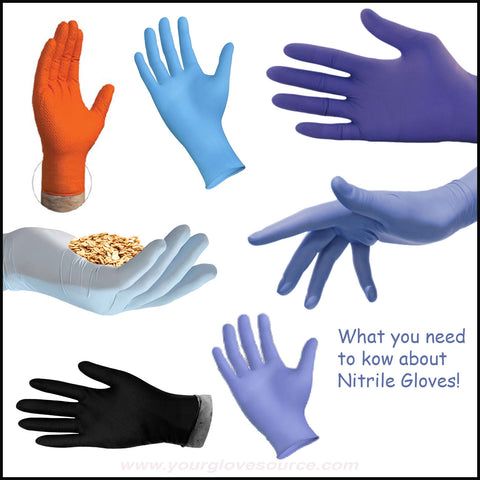This week we are Your Glove Source for Nitrile gloves. (Click here for a wide selection) Nitrile gloves are quickly growing in popularity, so in order to be informed to find the best Nitrile gloves for you, this article provides some isight of what you should know.
Accelerator Free Nitrile Gloves:
If you are at all familiar with Nitrile gloves, you know that these types of disposable gloves have become the new latex glove in the medical world. At the outset, Nitrile gloves provided an alternative for individuals who had a sensitivity or allergy to latex.
Manufacturers of Nitrile gloves worked to make these gloves as comfortable as latex, and for the most part succeeded. However, as individuals continued using these non-latex gloves, many people experienced painful rashes and discovered they had a Nitrile glove allergy. Manufacturers found that the Nitrile glove allergy was caused by the sulfur based chemical accelerators used in the production of Nitrile gloves. By manufacturing a new type of accelerator free Nitrile glove, customers are now able to find protective, disposable gloves that don’t contribute to Nitrile glove allergy.
Not only do accelerator free Nitrile gloves have fewer chemicals, but also they are found to be even stronger than traditional Nitrile gloves without compromising comfort. Accelerator free Nitrile gloves are a great option for all medical professionals, and some of the best accelerator free Nitrile gloves can be found here.
Nitrile Strength:
Despite the great benefits that come from Nitrile gloves including: alleviating allergies, and increased chemical and puncture resistance, the main drawback is that Nitrile gloves are less form fitting and not as soft as latex gloves. Nitrile manufacturers are trying to combat this downside by making Nitrile gloves that are thinner, so they feel and fit more like a latex glove. While the trend has been to go thinner with these gloves, it is being done without compromising strength.
Nitrile gloves are sold with a millimeter measurement, which describes the thickness of the glove. The man made Nitrile material provides all Nitrile gloves with increased strength and puncture resistance over latex gloves. The range in thickness of Nitrile gloves will more likely affect the chemical resistance of the glove, rather than the material strength.
Generally speaking, thinner Nitrile gloves will have lower chemical resistance and thicker ones will have greater chemical resistance. This being said, as you look to buy Nitrile gloves, it is important to obtain the chemical test data from your gloves’ manufacturer to be absolutely certain that you are receiving a glove that will withstand the chemicals you’re working with. For example, medical professionals working with chemotherapy drugs must insure that the gloves they use can stand up to those harsh chemicals.
Nitrile Glove Colors:
Nitrile gloves come in almost every color of the rainbow. Interestingly enough, the color of the glove does not in any way affect the quality of protection or strength offered by Nitrile gloves. Traditionally Nitrile gloves come in a blue hue in order to differentiate them as a non-latex glove for people with latex allergies. Now, the reason for such color variation in Nitrile gloves is mostly due to industry preference. For example, laboratory environments want to avoid any sort of cross contamination, so they’ll have different areas of the lab color coded with different gloves. This visual distinction helps to reduce cross contamination.

Black Nitrile gloves are generally preferred by law enforcement and postal workers. Law enforcement officers appreciate being able to distinguish themselves from medical professionals who are also first responders to emergencies. Postal workers use the black nitrile gloves so they can easily trace any white powders or residues that may turn up. Orange nitrile gloves are often used by auto mechanics and many applications that require a worker to be in dark confined spaces. The Hi-Vis nitrile color can visually aide in knowing where your hands are at all times. This is especially helpful in low light confined spaces. Using these types of gloves will also certainly add a level of safety.
As tradition holds most medical facilities still use a blue shade of Nitrile gloves, although other colors such as grey, purple and pink nitrile gloves are being used as well. A particular interesting use of different colored Nitrile gloves helps medical professionals recognize glove failure. For example wearing a red glove under a gray glove will help a medical professional notice when the gray glove has been punctured or ripped, because the red glove will show through.
Aside from these general industry preferences, the color of Nitrile you choose ultimately comes down to personal preference. Manufacturers are seeing that people enjoy having a variety of color, so look forward to more colors being introduced and marketed.






2 comments
Most of these gloves do have blue dye’s in them or dye’s in general. Their are nitrile gloves that are dye free in the marketplace.
We have an employee who is allergic to latex and blue #2 dye. We are using the purple nitric gloves and she is starting to have a reaction, so I was wondering if they use blue # 2 dye in the coloring of the gloves?